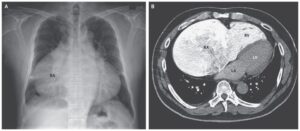This article is an answer to the Case – Patient with History of Esophageal Stenosis due to Chemical Burn
A 60-year-old man presented to our clinic with concerns about the cosmetic results of previous surgery. During childhood he had had an alkali burn of the esophagus that resulted in complete esophageal stenosis.
In 1962, when he was 7 years of age, an esophagogastric bypass was performed by means of subcutaneous colonic interposition that involved the creation of a cervical esophagocolostomy and an intraabdominal colojejunostomy.
A physical examination at the time of the current presentation revealed the subcutaneous position of the colonic segment on the chest wall as well as a herniation of the proximal jejunum through the epigastric opening of the abdominal fascia created for esophagogastric bypass. A water-swallowing test showed that he had normal swallowing function and passage through the jejunum.
The patient was offered surgical hernia repair, but after the operative risks were clarified, he declined to undergo surgery. Historically, the subcutaneous route for esophagogastric bypass was chosen — as in our patient — to avoid additional complications of surgery and anesthesia related to thoracotomy or retrosternal tunneling. Currently, colonic interposition, as well as subcutaneous positioning of the esophageal substitute, is rarely performed.

